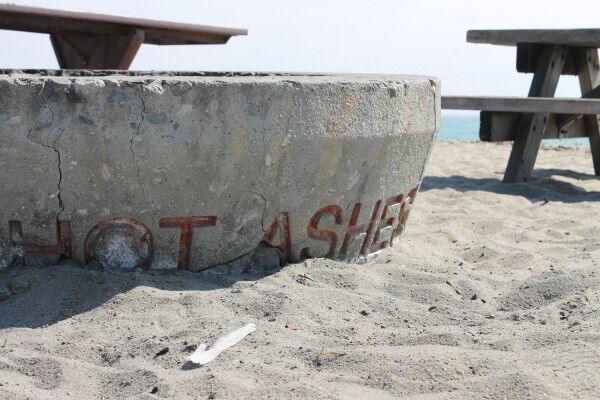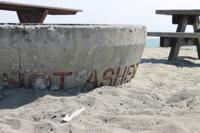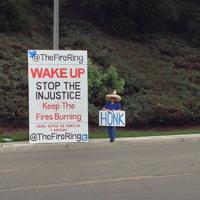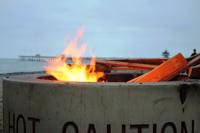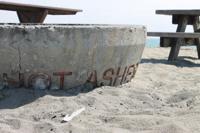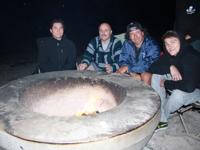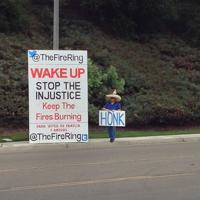San Clemente and Dana Point mostly unaffected by rule changes
By Jim Shilander
In a narrow 7-6 vote, the board of the South Coast Air Quality Management District voted to place restrictions on fire rings on beaches throughout Los Angeles and Orange County, although, as adopted, the fire rings on beaches in San Clemente would largely be unaffected, but the fate of some in Dana Point are still in question. The restrictions would go into place in March 2014.
The vote followed more than three hours of testimony and debate from residents and board members, with most of the residents coming from Orange County. Of the 49 speakers, only a few voiced support for the restriction.
As part of the resolution support, however, SCAQMD staff indicated that any future efforts to address the health effects from wood smoke would be based on non-regulatory approaches, such as through public education. Executive Officer Barry Wallerstein indicated the amendment as adopted would not be the agency “getting their foot in the door” to put further restrictions on fire rings.
In an air district staff presentation to the board, Philip Fine stated the district discovered what it considered to be unhealthy levels of particulates in the air at monitoring sites at Balboa Beach and Corona Del Mar, and those levels spiked during periods where beach fires were most prevalent.
Fine also noted that personal observations from staff confirmed smoke was largely coming from fire rings and not from other sources such as vehicles. The ill-health effects of wood smoke, he said, were also clear, noting that one pit produced similar carcinogenic effects as second-hand smoke from 800 burning cigarettes.

An advocate for beach fires outside the South Coast Air Quality Management District’s meeting discussing their fate on July 12. Photo by Jim Shilander
“The science is very clear. The evidence is clear,” Fine said. “It is coming from wood being burned in the fire rings.”
After an initially proposing to ban all fire rings throughout Los Angeles and Orange counties, the proposal was amended to allow fire rings in areas with a 700-foot buffer or at least 100 feet between each pit.
In some areas, such as San Clemente, with fewer pits, the 700-foot buffer area would not apply, but in Dana Point, 33 of the 47 beachside fire rings at Doheny State Beach are in jeopardy, according to Brian Ketterer, California State Park Superintendent for the Orange Coast District. The immediate impact on the fire rings was not known. Ketterer said he was in talks with the SCAQMD in order to comply with the new regulations, while also adhering to accessibility requirements set forth by the Americans with Disabilities Act.
SCAQMD spokesman Sam Atwood said the regulations would mean moving two of the five rings at Capistrano beach further apart.
Ten rings on the south end of the campground at Doheny State Park can be moved onto the campground itself, since non-beach areas are exempt from the regulation, Atwood said. The fate of the other fire rings at Doheny will depend on where the state places 11 rings that will be made accessible under ADA. The ADA accessible rings are exempt from the 700-foot buffer, but must still be at least 50 feet away from other fire pits, he said.
Fine also noted that the amended proposal allowed localities to exercise more control.
Elected officials from throughout Southern California, however, voiced opposition to the proposal.
State Sen. Lou Correa (D-Santa Ana) said as a teenager, he regularly made trips to Orange County beaches with his friends to use the fire pits. From a legislative perspective he said, the state had established the SCAQMD to fight major air pollution in Southern California.
“Nowhere do we believe the intent was to put out the pits in Huntington Beach and Newport Beach,” Correa said. “This is, with all due respect, the wrong solution at the wrong time. Don’t mess with tradition. It ain’t broke. Don’t fix it.”
Sen. Bob Huff (R-Diamond Bar), the state Republican leader, said the effort was an unjustified attempt to restrict the rights of people.
“The beaches belong to all Californians,” Huff said. “Why does government try to ruin everything that’s fun in life?”
The mayors of both Costa Mesa and Huntington Beach also voice opposition. Jim Righeimer of Costa Mesa said it was his city’s neighbors, Newport Beach “that started this mess.”
Air quality officials became involved earlier this spring after the California Coastal Commission indefinitely tabled a decision on whether or not the city of Newport Beach could remove its 60 rings. District spokesman Sam Atwood said the debate spurred the AQMD to examine the issue.
Those looking to restrict the fire pits had finally found a veil in which to cover their efforts, Righeimer said, which he believed were class and race-based, in the cloak of health. Righeimer said the health effects of exposure a few hours one night a week, were not significant, and urged the board to take no action.
Huntington Beach Mayor Connie Boardman said she had been told by SCAQMD staff that fire rings had not been “in the top 100 priorities,” before the issue arose with Newport Beach. The 700-foot barrier, she said, was essentially arbitrary, since there was no demonstrable difference between health effects at 400 or 500 feet.

Damon Kinnaman, Steve Bartock, Mark Hupert and Jonathon Bartock meet up often around a beach fire. Photo by Andrea Swayne
Councilwoman Leslie Daigle, from Newport Beach, said that although she had been among those who’d voted to ban fire pits from the community, she had reversed her position after hearing from constituents and others during the controversy.
“I’d urge you to drop any further consideration,” Daigle told the board.
She admitted to “not fully appreciating” the cultural impact of the fire pits. Daigle told board chairman William Burke that she did not know if her type of reversal had been made by her fellow council members.
Even though the amended proposal largely exempted the city, San Clemente City Manager Pall Gugeirsson told the board of the City Council’s opposition to the restrictions. No official from Dana Point spoke at the event.
While most of the public was opposed to the proposal, mostly focusing on the tradition of the fire rings, others, mostly from Newport Beach, voiced their support.
Jack Larson, of Corona del Mar, said due to the unique topography of the bluffs, smoke from the fire rings was essentially trapped in the area.
“I would like to have clean air,” Larson said. “I think I’m entitled to clean air just as much as everyone else.”
Charles Farrell, of Balboa, said his home was one of the closest to the pits. Rooms and closets in his home trapped the smoke, he said, meaning the air inside was often worse than outside. Farrell said he welcomed people to come to public beaches.
“We only ask one thing, stop the burning,” Farrell said. “Most beachgoers don’t want to be forced to smell the rotten stink.”
Barbara Peters, of Corona del Mar, was one of the first to ask for the ban. She reported that her home had been vandalized with “Keep Your Mitts Off Our Pits,” a slogan worn by those opposing the amendment at the meeting.
“Take a stand for science and health,” she told the board. “Make an ethical determination to value the public’s right to breathe clean air.”
Cade Myers, a Boy Scout from Rancho Santa Margarita, said the beach “was like a second home to my whole family,” during the summer.
“If you spend the day surfing or body boarding, it’s fun to just sit in front of the fire and get warm,” Myers said.
The 13 board members were also closely divided. Santa Ana Mayor Miguel Pulido said the issue was the toughest to confront the board during his time on it.
The revised amendment, however, reduced the number of areas affected by the proposal to “about 60 fire pits” mostly in Newport Beach. The district, he said, had more important things to deal with.
“This is just not worth the type of debate we’re having,” Pulido said.
Board Member Shawn Nelson, an Orange County supervisor, said the issue actually began about 10 years before, when a then-Newport city council member said the rings should be taken out to keep out the Mexican community.
“It started a long time ago, and it’s shameful,” Nelson said. “It’s not that they don’t want the fire rings, it’s about the people. And they’ve somehow co-opted this agency to bite this bait.”
If the city were to adopt this restriction, he said, it should outright ban all wood burning, including fireplaces, within 700 feet of human beings.
“We’ve stuck our nose where it really doesn’t belong,” Nelson added.
In response to Nelson, Chairman of the Board, Burke said, that as a veteran of the fight for civil rights in Los Angeles, he saw the issue as one of air, not of civil rights. He said that in conversation with his children, one had made the comment, ‘if you really believe the science, you’ve got to follow the science.”
San Bernardino County Supervisor Josie Gonzales said, in her mind, she needed to support the new rule, because health had to be the top priority.
“This staff has done a great job of walking an extremely tight rope here,” Gonzales said. “This is not a popularity contest. It’s a health concern.”
State Assemblyman Travis Allen (R-Huntington Beach), who opposed the ruling, said after the meeting that he would look “for a legislative fix,” especially since the SCAQMD was in conflict with the California Coastal Commission.
“We’ll fight to keep beach bonfires throughout California,” Allen said.

